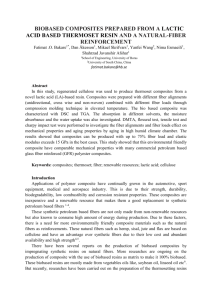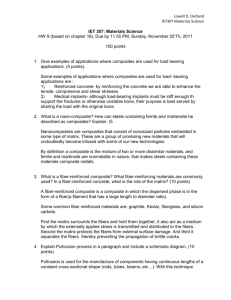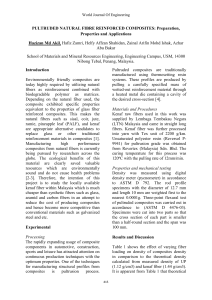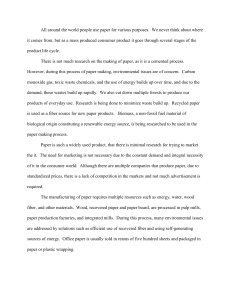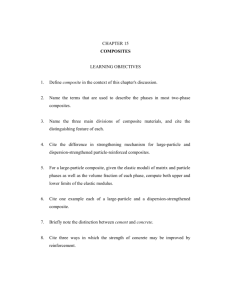Morphological and mechanical properties of a biobased composite
advertisement
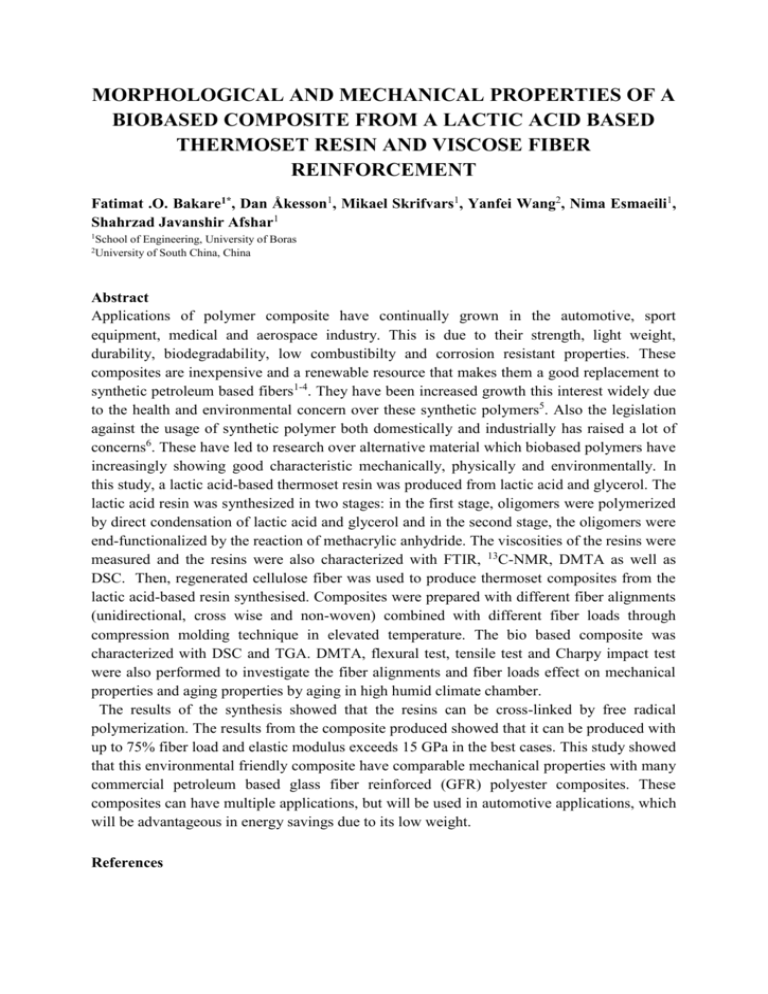
MORPHOLOGICAL AND MECHANICAL PROPERTIES OF A BIOBASED COMPOSITE FROM A LACTIC ACID BASED THERMOSET RESIN AND VISCOSE FIBER REINFORCEMENT Fatimat .O. Bakare1*, Dan Åkesson1, Mikael Skrifvars1, Yanfei Wang2, Nima Esmaeili1, Shahrzad Javanshir Afshar1 1School of Engineering, University of Boras of South China, China 2University Abstract Applications of polymer composite have continually grown in the automotive, sport equipment, medical and aerospace industry. This is due to their strength, light weight, durability, biodegradability, low combustibilty and corrosion resistant properties. These composites are inexpensive and a renewable resource that makes them a good replacement to synthetic petroleum based fibers1-4. They have been increased growth this interest widely due to the health and environmental concern over these synthetic polymers5. Also the legislation against the usage of synthetic polymer both domestically and industrially has raised a lot of concerns6. These have led to research over alternative material which biobased polymers have increasingly showing good characteristic mechanically, physically and environmentally. In this study, a lactic acid-based thermoset resin was produced from lactic acid and glycerol. The lactic acid resin was synthesized in two stages: in the first stage, oligomers were polymerized by direct condensation of lactic acid and glycerol and in the second stage, the oligomers were end-functionalized by the reaction of methacrylic anhydride. The viscosities of the resins were measured and the resins were also characterized with FTIR, 13C-NMR, DMTA as well as DSC. Then, regenerated cellulose fiber was used to produce thermoset composites from the lactic acid-based resin synthesised. Composites were prepared with different fiber alignments (unidirectional, cross wise and non-woven) combined with different fiber loads through compression molding technique in elevated temperature. The bio based composite was characterized with DSC and TGA. DMTA, flexural test, tensile test and Charpy impact test were also performed to investigate the fiber alignments and fiber loads effect on mechanical properties and aging properties by aging in high humid climate chamber. The results of the synthesis showed that the resins can be cross-linked by free radical polymerization. The results from the composite produced showed that it can be produced with up to 75% fiber load and elastic modulus exceeds 15 GPa in the best cases. This study showed that this environmental friendly composite have comparable mechanical properties with many commercial petroleum based glass fiber reinforced (GFR) polyester composites. These composites can have multiple applications, but will be used in automotive applications, which will be advantageous in energy savings due to its low weight. References 1 Kayode Adekunle, Dan Åkesson, and Mikael Skrifvars, J. Appl. Polym. Sci. 115 (6), 3137 (2010). 2 Erman Senoz, Joseph F. Stanzione,III, Kaleigh H. Reno, Richard P. Wool, Melissa E.N. Miller, J. Appl. Polym. Sci. 128: 983-989 (2013). 3 Yihong Shen, Shenghong Zhang, Hongjia Li, Yuan Ren, and Haichao Liu, Chemistry – A European Journal 16 (25), 7368 (2010). 4 Kayode Adekunle, Dan Åkesson, and Mikael Skrifvars, J. Appl. Polym. Sci. 116 (3), 1759 (2010). 5 Dan Åkesson, Mikael Skrifvars, Jukka Seppälä, and Minna Turunen, J. Appl. Polym. Sci. 119 (5), 3004 (2011). Jefferson Hopewell, Robert Dvorak and Edward Kosior, Phil. Trans. R. Soc. B 27 364 (1526) 2115 (2009) 6
